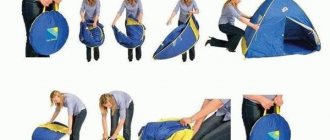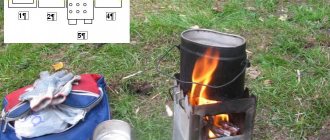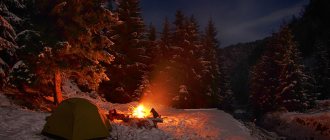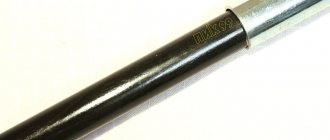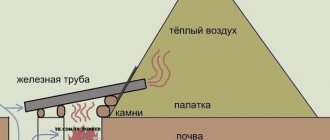The presence of a tent allows you to increase the total time a fisherman spends on a pond in winter. Moreover, you can easily raise the temperature in the tent to above zero, which will allow the fisherman to feel very comfortable.
Types of tents for ice fishing
Depending on the design features, winter tents are divided into specific models.
Umbrella
These are the simplest designs that are easy to assemble and install. To make the frame of such a tent, you should use durable but lightweight materials. Synthetic fabrics or their combinations with tarpaulin are more suitable as an awning for covering.
Machine

The design is designed in such a way that the frame acts as a spring, which takes the desired shape when it is released from the packaging. They are quite popular due to their simplicity of design and lightness. Despite this, these tents have a number of disadvantages. Firstly, they are not resistant to strong winds, and secondly, they are not so easy to fold. Therefore, when going fishing, you will have to practice beforehand. It unfolds itself, but without the skills, it will be very difficult to fold it and if you overdo it, you can break it.
Frame
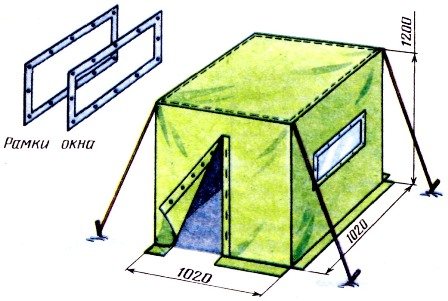
This tent consists of several folding poles and an awning that covers this frame. We can safely say that this is the same simple option, but it takes a long time to assemble and disassemble. In addition, it is not particularly durable. Therefore, fishermen rarely purchase such a design.
HOW TO MAKE A WINTER CHUM TENT / DIY / DO IT YOURSELF
Forced heating

The most effective way to insulate a winter tent is to use simple or complex heating devices or objects.
- The most affordable in this regard are ordinary paraffin candles. If the temperature is not too low, they will cope with this task quite well, especially if you place the candle in a thermos flask. This achieves two goals at once. Firstly, safety increases significantly, because even if you accidentally knock over such a heat source, you will not set anything on fire. Secondly, the flask itself warms up from the candle fire and begins to intensely radiate heat.
- In second place is the old, proven method of heating a tent using a hot stone. However, you will have to find this very stone, which is somewhat difficult to do in winter. Then make a fire, heat the stone on a live flame and bring it into the tent. To prevent it from burning the floor and melting the ice on the floor, you can place it in a metal pot, which, by the way, will increase the operating time of such a “heater,” or wrap it in several layers of foil.
- Gas heater. A special compact device running on liquefied gas, designed specifically for tourists, fishermen and other outdoor enthusiasts. There can be two types depending on the nozzle:
- With metal nozzle.
- With ceramic nozzle.
They are very easy to use and do not take up much space, but their operation is limited by the size of a stationary cylinder, so it is better to take a spare one with you.
- Gasoline heater. There are compact and inexpensive models. Unlike gas ones, they are even more unpretentious, but the fire hazard increases significantly. Requires increased attention and caution.
- And, of course, a wood-burning stove. Not very convenient for transportation. Of all the above options, heating a winter tent using a compact stove can be called the most ideal.
There is no need to be afraid of frost and hide your noses behind double-glazed windows and an insulated safe door. A winter trip to the bosom of nature, if well prepared for it, will give you indescribable pleasure, give you a huge boost of energy and lift your spirits for more than a day or two.
Requirements for a homemade tent for winter fishing

A tent for winter fishing should protect the fisherman from wind, frost and precipitation. Moreover, the tent should have enough space to relax so that you can cook lunch or just drink tea to keep warm.
You can purchase any tent at specialized retail outlets, especially since the assortment is very large. Be that as it may, some fishermen make them themselves, taking into account all the requirements. Besides, who else but the fishermen knows what kind of tent is needed. Moreover, not all factory-made models meet the requirements of winter fishing enthusiasts.
A homemade tent should be:
- quite light and compact;
- mobile so that you can move easily;
- covered with dense but breathable fabric;
- easy to install and dismantle;
- durable and strong, and also retain heat for a long time.
DIY winter folding tent for fishing!!!
Insulation methods
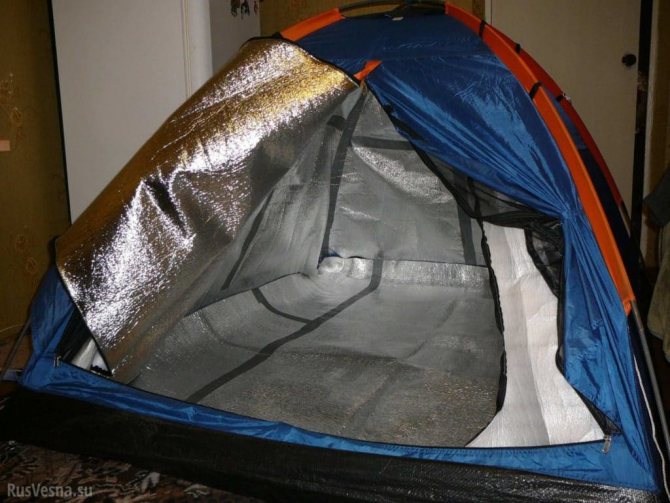
There can be several ways to insulate a tent with your own hands. Some of them can be used in combination, some exclude the rest. You can only choose after trying several times, but we will try to carefully consider the most popular ones to make your choice easier.
- Insulating a winter tent with polyethylene. The most affordable way to help protect yourself from rain and snow. However, he cannot save for long. Condensation will accumulate on the inside, and the material itself is quite light and it will be necessary to carefully secure it, at least with clothespins, and this will greatly increase the installation time of the tent.
- Double tent. Or an additional awning, which can be easily made from an old tent or a special cover can be sewn, for example from tarpaulin. This method is much more effective than polyethylene insulation, but requires additional preparation at home.
- Internal insulation. In specialized stores you can find a wide selection of isothermal insulation based on padding polyester, silicone and the like. They are covered with double-sided breathable fabric and provide excellent protection from moisture. Their cost, of course, is quite decent, but they also provide a solid guarantee of heat. There is also a more budget option: a heat reflector on foil, secured to the inner walls with clamps. You will have to tinker with it in the cold, but the heat from the heater will linger inside the tent much longer.
- Insulated floors. The main source of cold inside the tent is frozen ground, snow or ice if you are fishing. The simplest solution to cutting off this source is to use travel rugs. They are made of a special porous material and are intended specifically for this purpose. But it should be borne in mind that after some time they will begin to transmit heat downwards, which can lead to the melting of ice or snow and the formation of an elementary puddle right in the middle of the tent.
The listed methods, individually or in combination, will help keep the tent warm for a while and are used everywhere, especially if you are planning to be in nature for only a few hours. However, this is often not enough to spend the night on a pond or in a winter forest.
To work you will have to stock up on these tools

Most tents made by anglers themselves fit into a fishing box. By the way, you can also make a box yourself, which is what many fishermen do, although you can buy it. In addition to the box, you will need the following accessories:
- two pairs of skis, one for children, one for school;
- tubes. In this case, it could be ski poles;
- unnecessary folding bed;
- dense fabric, such as tarpaulin.
At first glance, how can you build a tent from such a set of elements? But, nevertheless, such a design proved that it has the right to life. The final product fits into a fishing box, which is very easy to transport on ice. The structure is quickly and easily assembled and just as easily moved on ice in working condition.
The only negative is that there is little space in it. But if you approach the problem constructively, then it is possible to solve it and increase the size of the tent. Paradoxically, it protects from the cold, and this is the main thing.
Instructions: place for a tent - how to choose
It should be immediately clarified that the issue of choosing a place for a tent should be taken up before dark. In the dark, it will be extremely difficult not only to assemble the structure itself, but also to assess the features of the terrain around the camp (Figure 1).
In fact, a camp can be set up on almost any site, but it is better to immediately choose the most suitable one so that the overnight stay is comfortable.
Flat, dry areas in young forests or undergrowth are best. It is advisable that there are no too large, old or dry trees nearby. If the wind suddenly rises at night, such trees may fall.

Figure 1. A resting place is selected and arranged before dark
The following basic tips will help you choose a suitable camp site:
- Be sure to inspect the ground in the selected area. It should be dry, without stones, stumps or roots protruding from the ground.
- If the place is suitable, be sure to clear it. It is necessary to remove all small stones, sticks and cut off protruding tufts of grass. Remember that even small debris on the ground will painfully dig into your back while you sleep. Naturally, this will not contribute to proper rest.
- To sleep warmer and softer, you can line the area under the tent with dry reeds or spruce branches. But make sure that the branches do not stick up, otherwise it will be uncomfortable to sleep, and sharp branches can even pierce the bottom of the tent.
- It is undesirable to equip shelter in hollows and lowlands. It's always very damp there, and if it rains at night, all the water will flow straight into the camp.
Coniferous forests are best suited for overnight stays. Here you can find spruce with fairly spreading branches. Almost nothing grows under such trees, and it will be very comfortable to sleep on the ground strewn with needles.
Drawings of a homemade winter tent

Judging by the drawings, the tent is mounted on skis, which simplifies its installation on ice. Regular tents require special fasteners. In addition, skis allow you to move the entire structure around the pond countless times. As a rule, winter fishing is not limited to one punched hole - there can be ten, or even more, and each hole has to be fished.
The only thing is that it is problematic to use it in the presence of strong wind, since it is mounted on skis, the wind will be able to move it across the pond on its own. In this case, you can get used to it and use the power of the wind to move it. The main thing is to drill the holes correctly.
Fishing in winter with a tent
A fishing tent is essential for avid all-weather winter anglers, allowing them to get out on the ice in harsh weather conditions. Even a small, cheap shelter without heating will save the situation, for example, in case of strong wind, in which it is impossible to sit. Fishing in a tent in winter is a special pleasure. The fisherman is comfortable, warm, and nothing distracts him from his favorite activity.

Step-by-step production

Despite the fact that this design was born a long time ago, many anglers have tested it in harsh winter conditions.
How to make a tent with your own hands
- Ski poles act as a frame and are installed vertically. Horizontal tubes should be thinner. At the corners, the frame is connected using tees, the diameter of which must match the diameter of both vertical and horizontal tubes.
- The next step is to attach the vertical tubes to the skis. A metal plate is attached to the ski, into which a tongue is inserted in the letter T, attached to the lower end of the tube. To secure the stick, just rotate it at an angle of 90 degrees.
- Two sticks are prepared from an old cot that will connect the frame to the box. Take a bent tube, at the end of which there is a docking unit. At the other end of the tube there is a latch, which serves as a fastening element for the docking unit.
- A spring is made from a copper strip that connects the box to the tubes.
- Finally, all that remains is to pull up the awning. Metal strips with holes are attached to the lower part of the awning. The brackets attached to the ends of the skis are pulled into these holes. The awning is connected to the brackets using ropes. For stable behavior of the tent on ice, it is equipped with two anchors.
Manufacturing
Assembly begins with the manufacture of the frame. First, a base is made from aluminum tubes. Then the load-bearing elements of the side walls and ceiling are attached. The optimal design is a dome design. After manufacturing the frame, it is checked for mechanical strength and reliability. Steel components with rust protection, stainless steel or special coating.

Checking patterns and fabric sizes. It is recommended to leave a small margin around the edges, 2-3 cm. Sewing the awning is done in two stages - first the outer layer and then the inner layer. You can make loops for attaching to the frame using removable rivets. The use of zippers is undesirable, since if moisture gets in, it will be difficult to open, and over time the metal will rust.
From experience, the first homemade fishing tent rarely turns out well. But the design can be modernized and changed. This will result in good homemade equipment that will not be inferior in quality to its factory counterparts.
How to sew a tent with your own hands
Alternatively, you can make a tent in the form of a house. To make it you need to take:
- Water-repellent fabric with an area of 14 square meters. meters.
- Metal washers, 1.5 mm in diameter, 20 pcs.
- Braided rope, up to 15 m long.
- Narrow ribbon, about 9 m long.
- Fabric for bedding, rubberized within 6 m.
Such a tent can accommodate one or even two people. First of all, you need to prepare two pieces of fabric measuring 1.8 x 0.9 m. Marks are made on the 1.8 m side every 65 centimeters. The same is done with the other (0.9 m) side. The fabric should be cut at the joining points to create the entrance and back wall of the tent.

The diagram shows the implementation of further work step by step. Most importantly, all parts must be sewn securely. Use tape to reinforce the seams. There are times when a tent is made from ordinary fabric. In case of bad weather, polyethylene film is used, which can protect against wind and precipitation. Metal rings are sewn into the fabric for fastening. As a rule, they are located at the bottom of the awning, as well as in the places where the fabric is attached to the frame.
Assessing safe overnight stays
Before you put up a tent and go to bed, you need to assess whether the chosen area is safe for spending the night.
First of all, experienced tourists do not recommend putting up a tent on a site with a slope. Of course, this is not life-threatening, but sleeping, constantly rolling to one side, will not be very comfortable.

Figure 2. A place to sleep must be absolutely safe
Try to look around and even wander through the nearby bushes. If there is an anthill nearby, the camp site will have to be moved, otherwise during the night the insects will try to get to your food and will definitely crawl into the tent. Other insects, in particular mosquitoes and midges, also pose some danger. They usually live in dense bushes or tall grass, so it is advisable not to camp in such areas (Figure 2).
Experienced tourists recommend setting up a tent not in an open area or a spacious clearing, but in a forest. It is much warmer under the cover of trees, and large forest clearings receive heavy dew in the morning. Accordingly, after waking up, not only the surrounding plants will be wet, but also the tent and you yourself.
In other words, try to choose a site so that your camp becomes a full-fledged vacation spot. Remember that at night the tourist should sleep, and not listen to surrounding rustling sounds and worry that animals will visit the camp or the tent will be washed away by heavy rain.
Materials
When choosing a winter tent for fishing, maximum attention should be paid to the materials from which it is made. Remember - frost and wind. The design should protect against these factors as best as possible. Other characteristics are also determined by the materials from which the product is made.
Frame
The frame determines the strength of the structure, its wind resistance and shape. It is made of plastic or metal.
Materials:
- Fiberglass;
- Carbon fiber;
- Kevlar;
- Graphite;
- Duralumin.
The simplest tents are equipped with a frame made of fiberglass or plastic. Cheap plastic guides are lightweight, but they break quickly and have different flexibility and strength at different temperatures. You need to work with such products carefully.
Metal frames are made from duralumin tubes marked D16T (Russian alloy) or Easton (USA). American tubes are stronger, lighter and 2-3 times more expensive.
Expensive tents can use high-quality Kevlar-graphite frames, which are not inferior in strength to metal ones. Such tubes are much lighter and, accordingly, even more expensive.
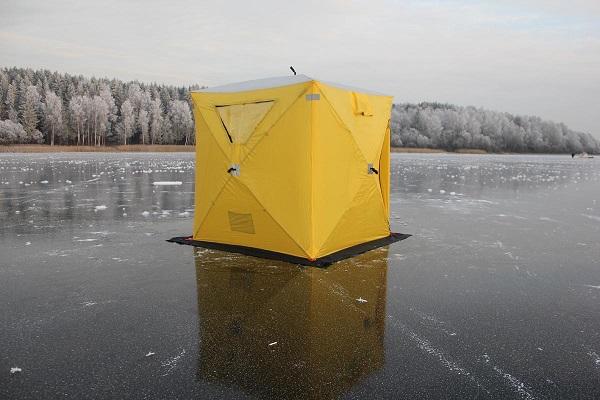
Cube
Awning
The awning determines thermal conductivity, strength and water resistance. The density of the tent fabric is indicated on the label; it is expressed in “tacks” - for example, 200t. This value varies in the range 175t-250t. Some manufacturers express it in “dens” (Den), from 200D to 420D. The higher this indicator, the stronger, thicker and heavier the awning. The density of the fabric also depends on the weaving method: ripstop, Tafetta or Oxford. In principle, any type of weave will do. Denser and stronger - reinforced fabrics.
Several types of fabric are used to make an awning. Awning materials:
- Mixed (old materials based on tarpaulin or cotton, cheap, non-moisture resistant, now almost never used).
- Polyamides (nylon, nylon) are the cheapest of modern materials, lightweight, durable, and moisture resistant. Disadvantages - they stretch when wet and gradually collapse when exposed to ultraviolet radiation.
- Polyesters (polyester, lavsan) are lighter and more expensive than the previous ones. Do not stretch when wet and are not affected by UV radiation.
- Polyolefins are the most modern, lightweight, durable, indestructible and incredibly expensive (in fishing tents - I’ve never seen them before).
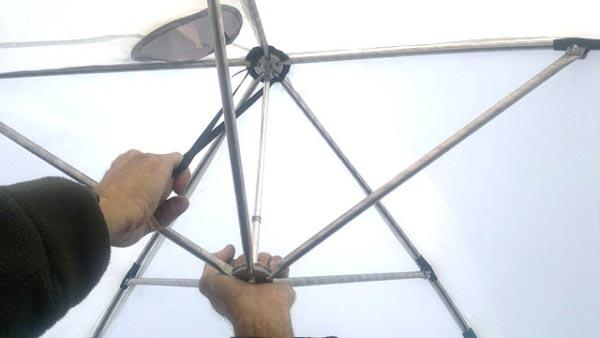
Umbrella frame
When purchasing, be sure to read the label. Everything that a tent “can do” is indicated on it. For example, Polyester RipStop 300T Pu 8000 means:
- Material – polyester;
- Weaving – ripstop (thread reinforcement);
- Fabric density – 300 tacks;
- Polyurethane impregnation (PU);
- Water resistance 8000 mm water column.
Be sure to check the locks, zippers, and seams. All key points - attaching loops to the awning, zippers, pockets, tunnels for the frame - must be stitched with a cross and around the perimeter with a dense thread and, preferably, glued. On high-quality tents, the door and window zippers on the outside are rubberized or impregnated with polyurethane.
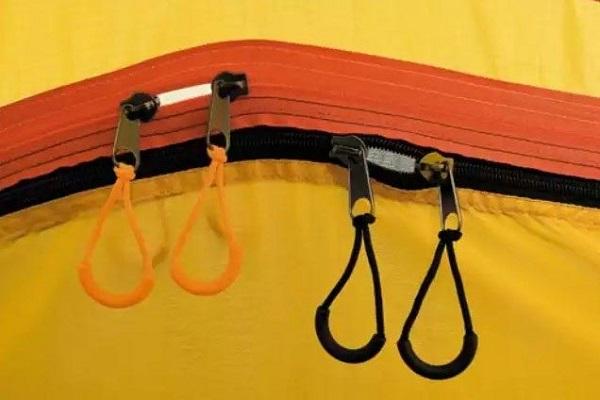
The quality of locks and zippers is the weak point of winter shelters
Bottom
Some fishing tents come with a bottom included. But this is rare. In cheap tents, instead of a floor, there is just a rag with a zippered window for holes. Many models do not have a bottom at all; the design ends with a special skirt (apron), which must be covered with snow from the outside (so that it does not blow from below). For most anglers, a winter tent floor is not necessary. But if someone wants to make their winter fishing base more comfortable, why not?
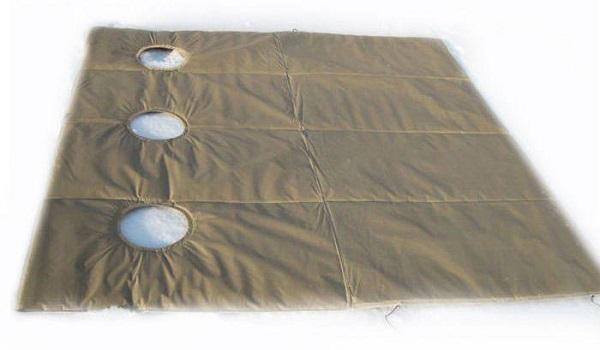
On sale you can find a floor for a winter fishing tent made of isolon (polyethylene foam). It consists of a layer of heat insulation, covered with fabric, with folds at the lower corners and holes for holes. But such bottoms have one drawback - they are only suitable for specific tent models. But this is not a problem - it’s very easy to create a warm floor for a tent with your own hands at home. The simplest option is to cover the ice with foam or penoplex, having previously adjusted the sheets to the correct dimensions. But in this case, you will also have to carry the floor with you on the sled.
A smaller solution is a folding floor made of isolon, stitched with fabric. You need to assemble it from pieces, then cover it with thick fabric. In those places where the pieces of insulator are connected there will be a bend for folding. Don't forget to cut holes for the holes! The main thing here is accuracy and the correct pattern of elements to fit the size. If there is also a stove in the tent, then you can fish in slippers (provided that there is no water on the ice).

Choosing the best option
Of course, one of the most important characteristics here will be the material from which the winter fishing tent is made. Thanks to technological progress, the most popular synthetic materials here are:
- Nylon;
- Silk;
- Lavsan;
- Polyamide and others.
All these materials are quite strong and durable. It is better to immediately exclude classic canvas tents from candidates due to their heaviness and high hygroscopicity. The outer layer of modern ones is water-repellently impregnated with polyurethane or silicone.
We advise you to read: Fishing for bream in winter
In the passport for each tent you can find not only the composition of the fabric, but also:
- the brand of its weaving,
- moisture resistance indicator
- density.
In order not to depress the future owner with numbers, we only note that the higher they are, the better the resistance of a particular fabric to rain, wind and snow. Compare the labeling of two or three competitors to your choice, and the situation will become clearer by itself.
The choice of manufacturers in favor of synthetic fabrics is quite logical. For one of the main criteria for fishermen’s temporary housing is its weight. In the vast majority of cases, the tent will have to be carried from the vehicle to the reservoir and back in your hands or on your shoulders. We agree that in addition to the obligatory ice auger, backpack, container with tackle and bait, an additional 5, 10, or even more kilograms is more than a significant burden.
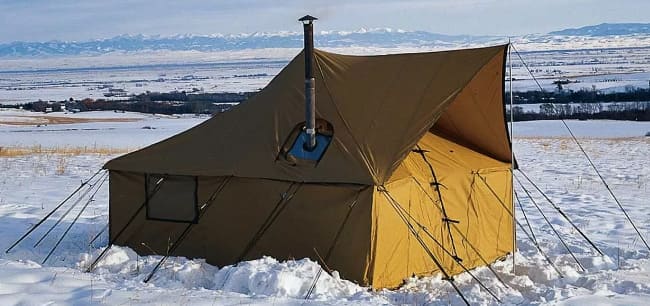
Installation and dismantling time is an important indicator
Another important indicator is the time for installation and dismantling. Few people come for fishing to catch fish and spend precious time building shelter from the wind and bad weather.
The speed record holders here are models from the “spring” and “umbrella” series. Where a few minutes are enough to open the tent, but their reliability leaves much to be desired. One way or another, it is impossible to ignore such an indicator as installation and dismantling time.
The reliability and stability of a tent is, first of all, determined by the quality of its frame. Aluminum and fiberglass will be a priority here over flimsy plastic or brittle metal profiles. In this aspect, you will also have to make a choice between weight and a guarantee of reliability.
Interesting article: Gerber ultimate knife (gerber knife) my review
Stability is important for a winter tent
The stability of fishermen's winter shelter largely depends on its shape. So a cube-shaped structure will have a much greater windage than a conical or hut-shaped one. Sloping walls and roof will not retain snow and melt water, so you will have to sacrifice free space.
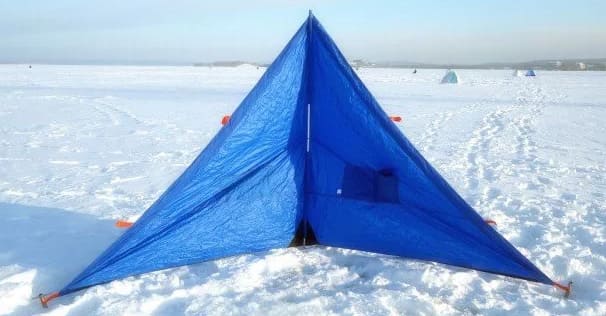
Almost every brand of manufacturer of tents for winter fishing has samples of one-, two-, and three-person tents. Experience has shown that a fisherman will feel quite comfortable if he is allocated at least 2 square meters. meters of territory.
Typically, tents for one person have three beams (ribs), and structures with a larger capacity have four or more. It follows that a one-person tent will always be less stable against the wind.
Along with the advantages, tents for winter fishing also have disadvantages. They limit your visibility and freedom of movement, make you less mobile on the ice and, of course, increase the volume and weight of your arsenal. And yet, having a tent for winter fishing is convenient, comfortable and much safer than fishing outdoors.
However, you have to pay for such convenience. Modern high-quality models of shelters from cold and bad weather are not cheap. Therefore, it is worth assessing the degree of necessity of this purchase, then read our advice again and only then go shopping. Only then will she be a joy to you. And every ice fishing trip will be filled with positivity, and an ice fishing tent will help with this.
Read us in:

